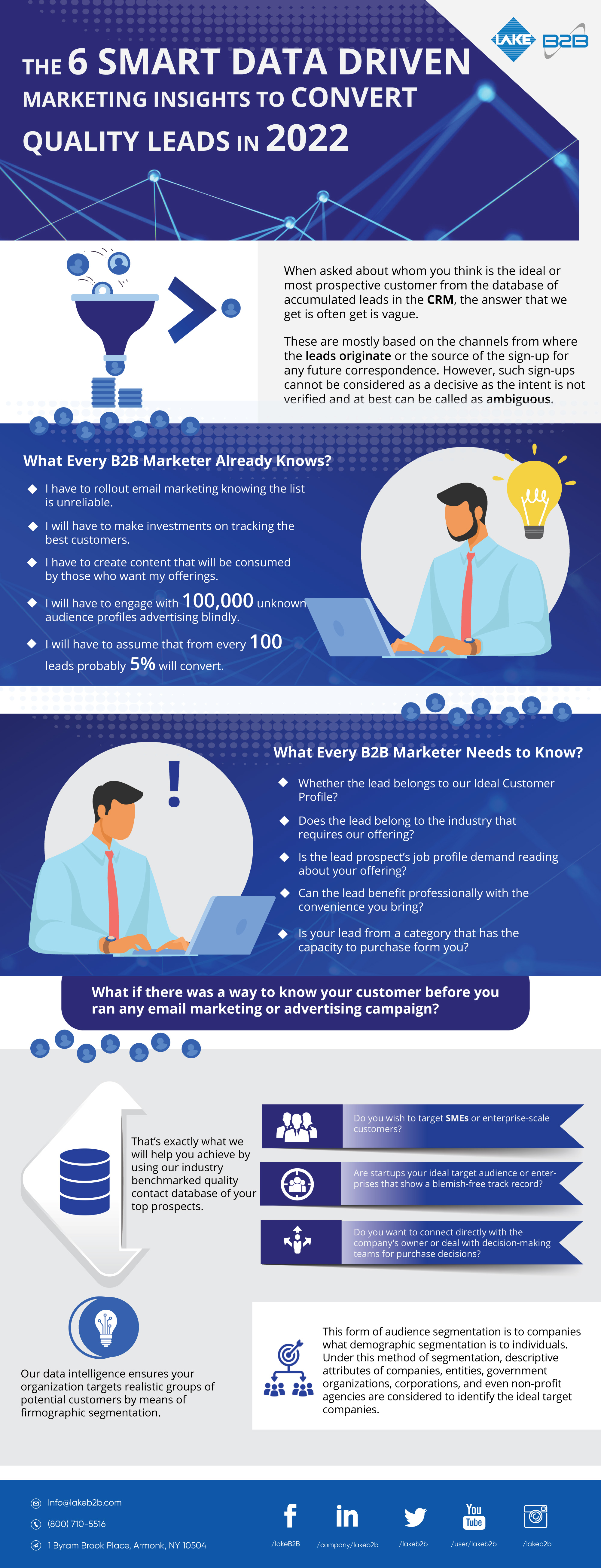
The 6 Firmographic Insights to Convert High Quality Leads in 2022
Author: Aaron Smith
- Discover how you can use firmographic data of your target audience for better conversions.
- Know the best way to ensure email list reaches only the right customers who want to buy.
There is no point of running marketing campaigns for erroneous audience sets – a majority of demo sign-ups with no intention for purchase either now or in the near future.
The biggest reason for non-converting sales leads is the very mindset of running campaigns without know who the target audience is. It becomes far easier to speak to a concentrated set of conversion-probable profiles than keep the flame of conversations alive with anyone and everyone.
Most B2B Marketers know the tactics to bring the leads from different channels. But are all the leads relevant?
- 92% of our Surveyed marketing leads who have used our services have claimed that they have all encountered the problem of excess leads flowing in.
- Many were experts in performance marketing and knew exactly which channels to go after but were helpless when it came to knowing if the targeted audience is genuine.
- Many sales leaders wanted their marketing counterparts to move beyond branding to anonymous personals and handover only the most profitable prospects.
| Uncover upcoming channels marketing and trends that must leverage with Lake B2B Data and Campaign Specialists. This is how you will launch precision targeted online campaigns in 2022. Read More | Learn how to engage with customers using these email marketing Dos and Don’ts. Lake B2B will help target profiles that are engaging and have potential to become paying customers in 2022. Read More |
With that being said, it is still important to keep an eye on the financial scenario of the companies. From the same example above, it could be possible that there are large enterprises that are currently experiencing an economic lag. As a result, they might be interested in your products and services. And you would do good to leverage this opportunity.Let’s understand firmographic segmentation with the help of a relevant example – An XYZ company wanted to market their sanitization services to companies and establishments with heavy COVID-19 restrictions in place.
Upon market analysis and research, they found that gymnasiums, restaurants, warehouses, and factories were the ideal customer segments. However, it was also observed that despite being at the center of the decision-making process, the owner was always likely to involve the operations staff in the decision-making process. And the staff, lacking proper knowledge, would always raise unfounded objections. As a result, the company decided to launch a podcast, webinar, and training program that would help eliminate some of the hesitation that was turning out to be a major obstacle. These initiatives ended up doing the trick.
This is just one drop of an example in the vast ocean of the B2B market where companies use firmographic segmentation on a non-negotiable basis. So, what are the different variables that marketers generally use to create lucrative market segments based on companies’ firmographics? Let’s find out.
1. Industry
Industry is perhaps the very first variable that organizations consider because it is a broad factor and self-evident that your products and services will not be suitable for every industrial sector. For instance – If you are a retail company that specializes in manufacturing construction materials, it’s highly unlikely that you would want to target a company from the education sector that is seeking to invest in education technology to help high school teachers deliver quality education to students. Not only that but this variable for firmographic segmentation can also be considered in creating custom landing pages for each industrial segment. For example – Suppose your company manufactures a CRM software that can be used by a couple of industrial segments but it offers some benefits that are more exclusive than the others. You can come up with an ad that highlights this benefit such as ‘financial services CRM’ or ‘best Healthcare CRM.’ In this way, personalizing marketing efforts becomes easy.
2. Size of the Company
This variable is important to be considered mainly for companies whose products and services can be used by a wide range of businesses, both large and small. The marketing message you use to target small companies cannot be the same as what you would use to target a large-scale enterprise. In some cases, even the product you need to advertise may differ. A simple example could be a company that sells cloud ERP solutions for both small and large enterprises. While developing the relevant marketing message for a small enterprise, you would probably want to advertise a version of the product that helps companies to grow with low cost of ownership. But since affordability won’t be a major concern for large enterprises, you might want to highlight other product features such as ability to manage multiple interconnected planning processes or how the software helps sustain global competitive advantage.
3. Annual Revenue
The third variable to consider for firmographic segmentation is the annual revenue of companies. This is crucial because you only want to target companies that can realistically afford the products and services you have to offer. Otherwise, you would end up wasting time and resources in the form of ad spend. Let’s take up the example of a CRM SaaS provider. The company’s solution may be affordable, and therefore, more applicable for small or even medium-sized enterprises that are looking to scale, and hence, looking for cost-effective solutions. In such a case, it makes little sense to target companies that are Fortune 500s to whom cost is not a worry.
4. Location of the Company
Where your target business is located may also significantly affect the outcome of your marketing campaigns. Location firmographics takes into consideration the city, state, town, country, or even continent in which the company is located.Take for instance, a company that is located in the Middle Eastern region who has not seen any progress with companies located in the far West in the US. In such a case, there is no point in marketing in that region. Here, it is important to consider the headquarters as well as the satellite offices of the advertising company. If there are no nearby offices to the customer company, it makes little sense to market to them or other companies in that direct region. So, always ask yourself whether your target company is located in a small town or a major city, whether they are an international brand, and what your proximity to that company is.
5. Sales Cycle Stage
This is mainly a contact-level firmographic segmentation of the audience. You cannot simply target them with generic content. Not all leads are the same stage of the sales funnel. Not only will the form of content you use need to change for each stage of the sales cycle but also the marketing message you use in it. For instance – If you target a lead in the awareness stage of the sales funnel with a product demo, they are most likely to ignore it, even if your product may actually help solve their pain-points. For such a lead, you need to start by trying to establish a relationship and gain their trust through digestible forms of content such as infographics, blog posts, and more. Each ad you use must be focused on pushing the customer to the next stage, hence you cannot afford to break the flow by popping in with an irrelevant message. Monitor your customers’ journey through the sales funnel and offer them content that aligns with their needs so as to avoid leakage.
6. Executive Title
This is another type of contact-level firmographic segmentation of your audience. It is important for you to know who the one(s) making the purchase decisions are. If you’re directly targeting the Chief Executive Officer (CEO) of the company, developing a singular message that resonates with them is enough.But suppose the decision-making panel includes a number of executive titles such as Chief Technology Officer, Chief Financial Officer, and more, you need to create separate hyper-personalized messages that can address the key areas each executive may be interested in. For instance – to the former, you might want to highlight how innovative your product is and how it can streamline the operations of the organization whereas for the latter, you might want to highlight how the product can help reduce costs and, if applicable, generate higher revenues, and so on. Within a single platform, say LinkedIn, you can develop different marketing messages to target different executive titles.
In Conclusion
The B2B marketing landscape is an intensely competitive environment. No company can act as everything to everyone, and the need for market segmentation proves this to be true. Are you choosing your battles well by selecting and removing certain segments from your marketing radar? Though it is true that advanced technologies have made it easier and more affordable to aim big, it’s still important to have a realistic view and avoid biting off more than you can chew. Consider some crucial factors like -In light of the many benefits that firmographic segmentation offers, the most important ones that we bring you at the most affordable cost are –
- New advertising opportunities
- Hyper-relevant messaging
- Better marketing ROIs
- Lower costs
- Helps understand trends
- Helps saves time
You cannot simply choose to ignore it. And if you ever find yourself doubting whether or not you should be using firmographics, remember the golden warning – If you choose to target everyone, you end up targeting no one.





